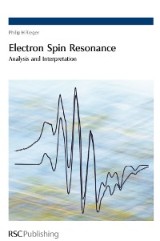Details

Electron Spin Resonance
Analysis and Interpretation1. Aufl.
|
104,99 € |
|
| Verlag: | Royal Society Of Chemistry |
| Format: | |
| Veröffentl.: | 31.10.2007 |
| ISBN/EAN: | 9781847557872 |
| Sprache: | englisch |
| Anzahl Seiten: | 286 |
DRM-geschütztes eBook, Sie benötigen z.B. Adobe Digital Editions und eine Adobe ID zum Lesen.
Beschreibungen
This book describes in mathematical terms the extraction of useful information from ESR spectra as applied to paramagnetic organic, inorganic and organometalic molecules. It lays a firm groundwork for understanding more sophisticated experiments, which the availability of newer commercial instruments has made possible. It takes the reader step by step through obtaining and interpretating ESR spectra of paramagnetic molecules. The mathematical basis of each observed phenomena are detailed and examples given. In particular there is a detailed discussion of 2nd order pertubation theory treatment of the Spin Hamiltonian for non-coincident G and A axes.
This book describes in mathematical terms the extraction of useful information from ESR spectra
Chapter 1: What is ESR Spectroscopy; The ESR Experiment; Sensitivity; Saturation; Nuclear Hyperfine Interaction; Operation of an ESR Spectrometer; Optimization of Operating Parameters; Applications of ESR Spectroscopy; Electronic Structure Determination; Analytical Applications;Determination of Rates;References; Chapter 2: Isotropic ESR Spectra; Line Positions in Isotropic Spectra;Hyperfine Coupling Parameters; Second-order Splittings; Spin Hamiltonian Parameters from Spectra; Interpretation of Isotropic Parameters; Linewidths in Isotropic Spectra; Incomplete Averaging of Anisotropies; Rates of Fluxionality from Linewidths; Organic Radical Reactions; Analysis of Isotropic ESR Spectra; Preliminary Examination of the Spectrum; What do you expect to see?; Are the Gross Features of the Spectrum Consistent with the Model?; An Example; Detailed Analysis for Determination of Parameters; Computation of Multiplet Intensity Ratios; Multiplet Patterns Due to Isotopomers; Second-order Shifts in Line Positions; Related Techniques (ENDOR); References; Chapter 3: Second-order Effects on Line Positions; Understanding the Variation in Line Widths; Puzzling Line Shapes; Use of ESR Spectra to Determine Formation Constants; References; Chapter 4: Introduction: Solid-State ESR Spectra; Spectra of Dilute Single Crystals; Analysis of Frozen Solution Spectra; Interpretation of the g-Matrix; Interpretation of the Hyperfine Matrix; Organometallic Examples; A Low-spin Manganese(II) Complex; Some Cobalt(0) Radical Anions; Organic Examples of Solid-State ESR Spectra; Irradiated Single Crystal Of Glycylglycine; X-irradiated Single Crystal of Methylene Diphosphonic Acid; Non-Coincident Matrix Axes; Symmetry Considerations; Experimental Determination of Matrix Axis Orientations; Organometallic Examples of Non-Coincident Matrix Axes; A Chromium Nitrosyl Complex; Iron Pentacarbonyl Ions; Another Low-Spin Manganese(II) Complex; Chromium(I) Piano-Stool Complex; [(RCCR')Co2(CO)6]- and [SFeCo2(CO)9]-; (o-xylylene)-Mn(dmpe)2; Cobalt Dithiolene Complexes; "g-Strain"; References; Chapter 5: Bloch's Phenomenological Model; Derivation of the Bloch Equations; Steady-State Solution; Chemical Exchange-The Modified Bloch Equations; Further Discussion of Line Shapes; Applications of the Modified Bloch Equations; Alternating Linewidth Effects; Spin Labels; References; Chapter 6: Biradicals; Exchange Coupling; Organic Triplet-State Molecules and the Dipolar Interaction; Organic Triplet-State Molecules; Transition Metal Complexes with S>1/2; Spin-Orbit Coupling; High-Spin Transition Metal Ions; Examples: K3Cr(CN)6 and K4V(CN)6; References; Chapter 7; Second-order Perturbation Theory Treatment of Spin Hamiltonian with; Non-Coincident g- and A-Axes; The Electron Zeeman Term; Nuclear Hyperfine Interaction; Perturbation Theory Treatment of Hyperfine Term;Example of Application of These Results; Quadrupole Coupling; Perturbation Theory Treatment of Quadrupole Term; Example of Application of Analysis of Quadrupole Effects; References

















